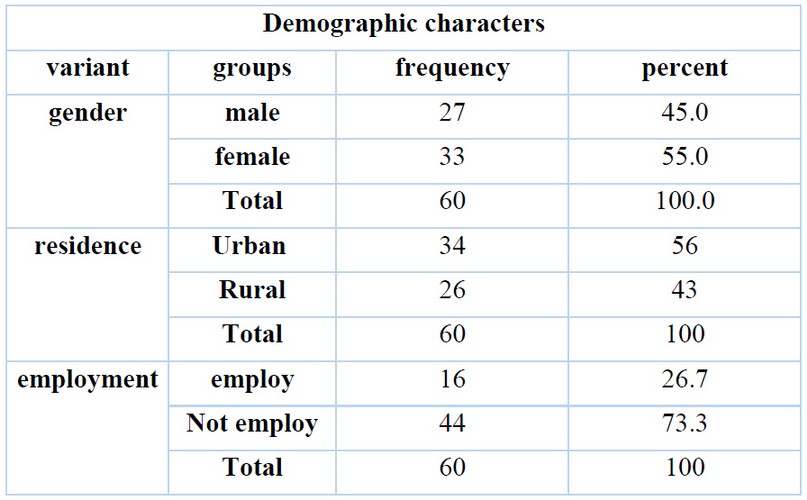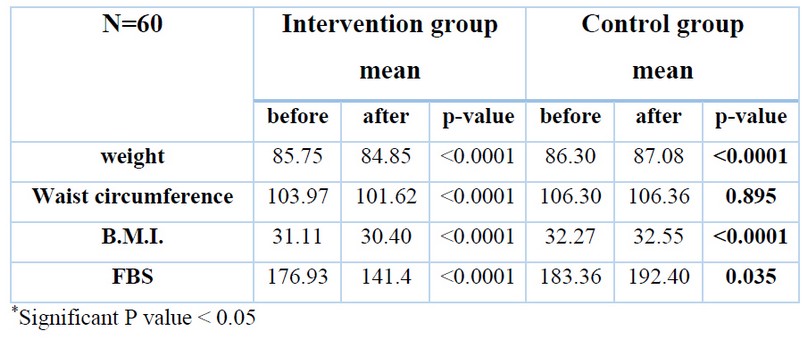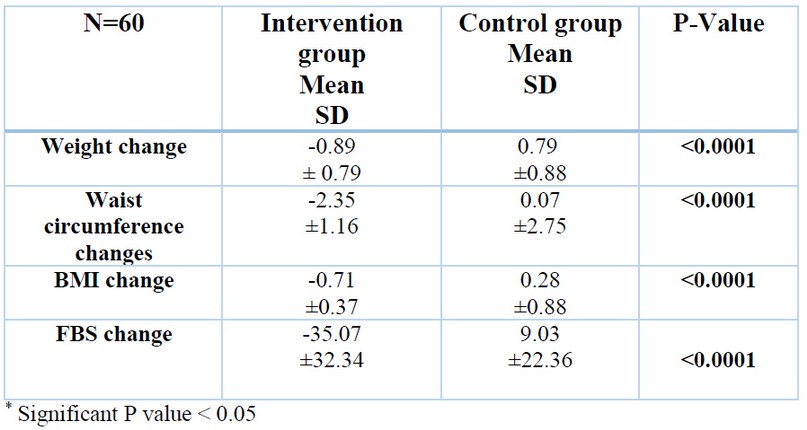2021.06.04.24
Files > Volume 6 > Vol 6 No 4 2021
Effect of cinnamon on blood sugar and anthropometric measurement in type two diabetes patients
Alaa Moyasser Sadiq 1*, Najah Salman Abid2, Ola Hussein Jasim 3, Besmah Mohammed Ali 4
Available from: http://dx.doi.org/10.21931/RB/2021.06.04.24
ABSTRACT
There is some emerging evidence that suggests certain supplements help lower blood sugar levels. One of these is cinnamon, which exhibits characteristics that mimic insulin, such as the activity of biologically active substances to activate insulin receptor kinase, increasing glucose uptake, autophosphorylation of the insulin receptor, and glycogen synthase activity. To assess the effect of the cinnamon substance on lowering fasting blood sugar, modifying body weight, body mass index (B.M.I.), and waist circumference in type two diabetics. A randomized controlled intervention clinical trial. The study was conducted on 60 patients with type II diabetes mellitus; the study followed both gender patients for four weeks. The contributors were allocated randomly into a group that receives 2 g/d cinnamon substance (intervention group), and a group without cinnamon substance is given (control group). Fasting plasma glucose (F.P.G.) and anthropometrics measurement at the beginning (beforehand cinnamon supplementation and 4week at the end of the study duration). After 4 weeks of cinnamon taken, serum F.P.G. levels significantly improved (P≤0.0001). Anthropometric measurements (weight, height, B.M.I.) were reduced significantly (change mean ≤ P=0.001) for all. The Present study disclosed that supplementation of 2 gm cinnamon improves F.P.G. and has a good role in anthropometric indices (weight, waist circumference, B.M.I.).
Keywords. Cinnamon, T2DM, F.B.G., B.M.I.
INTRODUCTION
The diabetes epidemic is predictable to grow more threatening over the next several years. By the year 2050, it is projected that 1 out of 3 persons will have diabetes1 T2DM is categorized by a mixture of insulin resistance (reduced tissue sensitivity or receptiveness to insulin) and beta-cell failure2. Prediabetes is the subclinical changes in fasting plasma glucose, impaired glucose tolerance, or both. The degree of changes is among euglycemia, and the hyperglycemia of type T2DM3 Medical Nutrition Therapy delivered is also fruitful and crucial to preventing the development of prediabetes and obesity from typing T2DM4 cinnamon has a natural substance of attention because it has been theorized to deliver health benefits, such as the capability to lesser blood glucose and serum lipids. The insulinotropic properties of cinnnamaldehyde have been preliminarily examined and are supposed to be accountable for indorsing insulin release, increasing insulin sensitivity, enhancing insulin disposal, and employing activity in insulin receptor kinase and the instruction of protein-tyrosine phosphatase 1B (PTP1B)5Additional, methyl chaconne polymer present in cinnamon augments the triacylglycerol lipase action that hydrolyzes fat molecules in diet, rises glycogen synthesis in the liver, augments glucose uptake and phosphorylation skeletal muscles and adipocytes insulin receptors6 Cinnamon act as a natural lipase inhibitor generally used in traditional medicine to reduce cholesterol and body weight7 A four-month management with a dietary addition encompassing cinnamon, chromium and carnosine reduced fasting blood sugar and augmented fat-free mass in obese or overweight pre-diabetic subjects 8 Cinnamon consumption for short period is related to a notable decrease in both systolic B.P. and diastolic B.P., Though cinnamon demonstrates positive effects on potential lowering B.P., It would be early to indorse cinnamon for control B.P. as the restricted available studies 9 . Cinnamon is known to have anti-diabetic properties, in addition to which, it is also perceived to have anti-oxidant, anti-inflammatory and anti-bacterial properties10 cinnamon is currently marketed as a remedy for obesity, glucose intolerance, diabetes mellitus and dyslipidemia10,11 At present cinnamon is sold as both a preventative and therapeutic supplement for many ailments including, metabolic syndrome, insulin resistance, type 2 diabetes, hyperlipidemia and arthritis 10 .
The study's objectives were to assess the effect of cinnamon on lowering fasting blood sugar, modifying body weight, body mass index (B.M.I.), and waist circumference in type two diabetics.
MATERIALS AND METHODS
Study design
A randomized clinical controlled trial intervention design (pre& post) which accompanied at the Al-wafaa Specialist Center for Diabetes and Endocrine Disease /Nenaveh Health Directorate in Iraq and was carried on T2DM patients (N=60) with uncontrolled diabetes mellitus patients, male and female patients aged (25 – 70) years.
Exclusion criteria
Exclusion criteria from taking the cinnamon supplement, acute concurrent illness, upper G.I.T. disease (GERD, gastritis, peptic ulcer), cancer, allergy to cinnamon, asthma & difficult breathing lactation, and pregnancy were excluded from the study. History was taken of Medical, surgical, drug, and usual diet history at the beginning of the trial. All contributors were taught to maintain their usual dietary behaviors and physical activity throughout the study.
Participants
The study's two groups were randomly divided into the intervention group (n=30) receiving cinnamon substances and the control group(n=30) without cinnamon supplementation. Cinnamon capsules were already prepared and given as 2 gm as two capsules in two divided doses with lunch and dinner daily for 4 weeks. Compliance with taking cinnamon has been done by checking the capsule containers.
Biochemical analysis-anthropometric measurements
F.P.G. was measured and recorded at the beginning (before cinnamon substance supplementation) and the end of the study. Venous blood samples (1 cc) were collected afterward fast overnight for measuring fasting blood sugar. Blood sample for F.B.S. assay directly analyzed.
Measurement of weight was done by the standardized scale and for height by a standardized stadiometer. B.M.I. was calculated by dividing weight (Kg) by squared height (m2) at the beginning and the end of the study and categorized according to WHO criteria. The WHO procedure instruction for assessing waist circumference is that the measurement is prepared at the estimated midpoint among the lower margin of the last rib and the iliac crest top.
Anthropometrics measurements are a series of quantitative measurements of the muscle, bone, and adipose tissue used to assess the body's composition. The elements of anthropometry are height, weight, body mass index (B.M.I.), body circumferences (waist, hip, and limbs), and skinfold thickness.
Statistical analysis
Version 21 of IBM SPSS has been used for analytic statistics. Participant representative data are offered as mean, range & S.D. Paired sample t-test was used to compare the characteristics of the study group before and after their Intervention (P-value=0.05). T-test Independent samples were used to evaluate the difference between the intervention and control group in the mean change of study group characteristics (P-value <0.05). The mean alteration characteristics of the study group (P-value<0.05) were considered significant.
Ethical permission
Permission to pilot the study was gained from Nenaveh Health Directorate in Iraq authorities. After elucidating the objects of the study for patient& relatives and earnings agreement for diabetes patients comprising in this study, privacy and confidentiality was considered. Also, allow the participant to leave the study at any time have been decided and provide them with complete information about cinnamon substance with its side effect and role in Type two D.M. also, I got signed consent from intervention and control groups participate in the research.
RESULTS
Patients in this study had a mean age of 50.6±9.3 years, cutting-edge within the range of 25-70 years. The male constituted 45%, and the female was 55%. Regarding residency, 56% of residence were in urban areas while 43 % lived in rural regions; As seen in the table (1). According to the mean duration of diabetes mellitus in participants was 6.6±5.9.

Table 1. The demographic characters.
The Comparisons characteristics of the study group before and after the intervention (4 weeks after cinnamon intake) (table 2). The difference between the intervention and the control group in the mean change of characteristics study group (table.2).
The patients were monitored for four weeks, the mean level of F.P.S. for the intervention group at the beginning of the study was 176.93, and after follow-up, the mean level was 141.4; this difference was highly significant.
Anthropometric measurements (weight, waist circumference) decreased during the study period in the intervention group with a p-value <0.0001 for both. The B.M.I. mean level became better after supplementations of cinnamon with a p-value was <0.0001 in the intervention group (table2).

Table 2. the Comparisons characteristics of the study group before and after the intervention.

Table 3. Shows the difference between the intervention and the control group in the mean change of the characteristics study group.
DISCUSSION
Most patients with type two diabetes tend to ingest alternative medication to regulate their blood sugar; cinnamon is the most frequent. There are (4-18) weeks for cinnamon supplementation in patients with type two diabetes for their health status improvement with doses (150 mg/day-6 gm/day) 2.
This study aims to assess the effect of cinnamon supplementation of 2 gm daily dose for four weeks on F.B.S., B.M.I., weight, waist circumference; we found a significant statistical improvement while no significant statistical difference in HbA1c.
Effect on F.B.G
In a meta-analysis of ten randomized controlled trials (n = 543) patients, a cinnamon substance with doses of (120 mg/d - 6 g/d )for four to eighteenth weeks, levels of fasting plasma glucose reduced with a mean difference (–24.59 mg/dL; 95% CI) with upper & lower limit( –40.52 to –8.67 )mg/dL) consequently.5 Another intervention study with a single cinnamon supplement (3g) during 16 weeks resulted in improvements in fasting blood sugar & all constituents of metabolic syndrome significant in a sample of Asian North Indian sample patients6 Based on the study designed as a triple-blind placebo-controlled randomized clinical trial in Iran findings was, cinnamon could improve FBS12 the different findings of another intervention study that also done in Iran concluded that an 8-week of 3 grams per day intake of cinnamon supplementation had no significant effects on F.P.G. 13
Effect on weight
A systematic review plus controlled clinical trials (meta‐analysis) revealed that supplementation with cinnamon significantly decreases body weight. But we need long‐term Randomized controlled trials that are recommended of high quality to approve these results14. Another study of Randomized controlled trials found that adding cinnamon, magnesium, and chromium supplements to honey of kanuka type was accompanied by weight reduction 15. Though cinnamon supplementation caused alterations in the weight, the result changes were statistically insignificant of that systematic review and meta-analysis of clinical trials stud16. Another systematic review and meta-analysis of clinical trials found that cinnamon intake had no beneficial changes on anthropometric parameters17.
Effect on waist circumference
The significant reduction in waist circumference is in type two diabetes patients who took three months' cinnamon substance16 A controlled intervention randomized clinical trial (triple-blind) revealed that Cinnamon supplementation was directed to improve anthropometric measures (B.M.I., body fat, and visceral fat)12.
A Randomization effects model with meta‐analysis (controlled clinical trials) found that Cinnamon supplementation affects insignificantly waist circumference14 Cinnamon Supplementation can reduce blood glucose without changes in anthropometric indices, including waist circumference17.
Effects on B.M.I
Our study result agree with R.C.T.s in which Cinnamon supplement steered to the improvement of B.M.I. and body fat were significantly more noticeable in patients with high B.M.I. diabetes patients (B.M.I.≥ 27)12 Twenty‐one R.C.T.s of 1,480 diabetes patients were comprised, The meta‐analysis displayed a significant reduction of B.M.I. with cinnamon supplementation.14 Inconsistent with our study, a systematic review & clinical trials meta-analysis for type 2 diabetes patients no significant effect of cinnamon supplementation on the B.M.I. 16 Also another systematic review of clinical trials & meta-analysis Cinnamon supplementation cannot improve B.M.I. in type 2 diabetes patients17.
Limitation of study
The short study period was short because I was limited in period time and because of COVID-19 lockdown, lack of previous studies in the research area, need more research with a large sample size, and one participant was excluded from the intervention group because he complained of gastritis.
CONCLUSION
the results of this study revealed that a two-gram daily dose of cinnamon improves fasting blood glucose, anthropometric parameters (weight, waist circumference, B.M.I.). However, it has no significant consequence on HbA1C after four weeks of supplementation of type II diabetic patients. Hence cinnamon could have an essential role in postponing or avoiding the progression of Type II diabetes, and we need further research, especially in Iraq.
REFERENCES
1. Kane K & prelack K. Advanced Medical Nutrition Therapy. Jones & Bartlett Learning.2019: 252p.
2. Raymond j & Morrow k. Krause and Mahan's Food & The Nutrition Care Process. Fifteenth Edition, Elsevier Copanies .2021 :830p.
3. Braga T, Kraemer-Aguiar L G , Docherty N G, Le Roux C W. Treating Prediabetes: why and how should we do it?. 2019 Feb;110(1):52-61.
4. Early K B, Stanley K. Position of the Academy of Nutrition and Dietetics: The Role of Medical Nutrition Therapy and Registered Dietitian Nutritionists in the Prevention and Treatment of Prediabetes and Type 2 Diabetes. J Acad Nutr Diet ,2018 Feb;118(2):343-353.
5. Allen R W, Schwartzman E, Baker W L. Coleman C I, Phung O J. Cinnamon Use in Type 2 Diabetes: An Updated Systematic Review and Meta-Analysis. Annals of Family Medicine .2013 Sep/Oct; Vol 11:5.
6. Jain S G, Puri S, Misra A,Gulati S ,Mani K. Gupta Jain . Effect of oral cinnamon intervention on metabolic profile and body composition of Asian Indians with metabolic syndrome: a randomized double -blind control trial. Gupta Jain et al. Lipids in Health and Disease .2017;16:113.
7. Khedr N F, Ebeid A M, Khalil R M. New insights into weight management by orlistat in comparison with cinnamon as a natural lipase inhibitor.Endocrine. 2020 Jan;67(1):109-116.
8. Liu Y, Cotillard A, Vatier C, Bastard JP, Fellahi S, et al. (2015) Correction: A Dietary Supplement Containing Cinnamon, Chromium and Carnosine Decreases Fasting Plasma Glucose and Increases Lean Mass in Overweight or Obese Pre-Diabetic Subjects: A Randomized, Placebo-Controlled Trial. PLOS ONE14. 2015 Dec ;10(12): e0145315.
9. Akilen R, Pimlott Z , Tsiami A, Robinson N. Effect of short-term administration of cinnamon on blood pressure in patients with prediabetes and type 2 diabetes. Nutrition 2013 Oct;29(10):1192-6. doi: 10.1016/j.nut.2013.03.007. Epub 2013 16 July.
10. Medagama A B. The glycaemic outcomes of cinnamon, a review of the experimental evidence and clinical trials. Medagama Nutrition Journal .2015 ;14:108.
11. Rafehi H, Ververis K, Karagiannis TC. Controversies surrounding the clinical potential of cinnamon for the management of diabetes. Diabetes Obes Metab. 2012;14(6):493–9.
12. Zare R , Nadjarzadeh A, Zarshenas M M , Shams M, Heydri M . Efficacy of cinnamon in patients with type II diabetes mellitus: A randomized controlled clinical trial. 2019 April;38(2): 549-556.
13. Talaei B, Amouzegar A, Sahranavard S, Hedayati M, Mirmiran P, Azizi F. Effects of Cinnamon Consumption on Glycemic Indicators, Advanced Glycation End Products, and Anti-oxidant Status in Type 2 Diabetic Patients. Nutrients. 2017;991(9).
14. Yazdanpanah Z , Azadi‐Yazdi M, Hooshmandi H, Ramezani‐Jolfaie N, Salehi‐Abargouei A. Effects of cinnamon supplementation on body weight and composition in adults: A systematic review and meta‐analysis of controlled clinical trials. Phytother Res.2020 Mar;34(3):448-463.
15. Whitfield P, Parry-Strong A, Walsh E, Weatherall M, Krebs J D. The effect of a cinnamon-, chromium- and magnesium-formulated honey on glycaemic control, weight loss and lipid parameters in type 2 diabetes: an open-label cross-over randomised controlled trial. European Journal of Nutrition.2016 Apr;55(3):1123-1131.
16. Jamaliab N, Jalalibc M, Saffari-Chaleshtori J, Samare-Najafab M ,Samarehe A. Effect of cinnamon supplementation on blood pressure and anthropometric parameters in patients with type 2 diabetes: A systematic review and meta-analysis of clinical trials. Diabetes & Metabolic Syndrome: Clinical Research & Reviews. 2020March–April;14(2):119-125.
17. Namazia N, Khodamoradib K , Khamechic S P, Heshmatid J, Ayatic M H , Larijanie B. The impact of cinnamon on anthropometric indices and glycemic status in patients with type 2 diabetes: A systematic review and meta-analysis of clinical trials. Complementary Therapies in Medicine. 2019 April;43:92-101.
Received: 7 July 2021
Accepted: 7 September 2021
Alaa Moyasser Sadiq 1*, Najah Salman Abid2, Ola Hussein Jasim 3, Besmah Mohammed Ali 4
1*. Clinical Nutrition Fellowship A.B.H.S, M.O.H., Iraq.
2 Iraqi Center for Heart Disease.
3 Clinical Nutrition Fellowship of A.B.H.S., Community Medicine Specialist at AL-Mahmoudiyah district of P.H.C.
4 Head of Scientific Council of Clinical Nutrition fellowship/ Arab Board, Ghazy Al-Hariri Hospital for Surgical Specialties
Corresponding author: Alaa Moyasser Sadiq [email protected]
https://orcid.org/0000-0001-5588-418X
